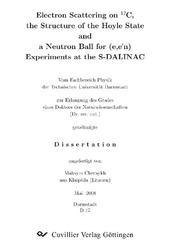| Departments | |
|---|---|
| Book Series (96) |
1377
|
| Nachhaltigkeit |
3
|
| Gesundheitswesen |
1
|
| Humanities |
2361
|
| Natural Sciences |
5403
|
| Mathematics | 229 |
| Informatics | 318 |
| Physics | 979 |
| Chemistry | 1362 |
| Geosciences | 131 |
| Human medicine | 243 |
| Stomatology | 10 |
| Veterinary medicine | 108 |
| Pharmacy | 147 |
| Biology | 835 |
| Biochemistry, molecular biology, gene technology | 121 |
| Biophysics | 25 |
| Domestic and nutritional science | 45 |
| Agricultural science | 1004 |
| Forest science | 201 |
| Horticultural science | 20 |
| Environmental research, ecology and landscape conservation | 148 |
| Engineering |
1788
|
| Common |
97
|
|
Leitlinien Unfallchirurgie
5. Auflage bestellen |
|
Advanced Search
Electron Scattering on 12C, the Structure of the Hoyle State and a Neutron Ball for (e,e'n) Experiments at the S-DALINAC (English shop)
Maksym Chernykh (Author)Preview
Table of Contents, Datei (41 KB)
Extract, Datei (120 KB)
The present thesis consists of two parts. Part I is devoted to the study of the second Jpi = 0+ state (Hoyle state) in 12C. Part II deals with the construction of a neutron detector ball for the electron scattering coincidence experiments.
The monopole matrix element for the transition from the ground state to the Hoyle state in 12C through internal pair production is an important quantity for calculation of the 3a reaction rate in supernova nucleosynthesis. Therefore, a new value for the monopole matrix element has been extracted using the high-precision electron scattering data. The 12C(e,e´) experiment was carried out at the Lintott spectrometer at the S-DALINAC with beam energies between 29.3 MeV and 78.3 MeV and scattering angles between 69° and 141°, corresponding to momentum transfers q = 0.2 – 0.7 fm-1. An energy resolution aE ≈ 28 keV (FWHM) was achieved. A pair width T pi = 62.2(10) x 10-6 eV was extracted combining a model-independent analysis of the data in the measured momentum transfer range based on plane-wave Born approximation as well as a Fourier-Bessel analysis covering a large momentum transfer range up to 3.1 fm-1.
Furthermore, the intrinsic structure of the Hoyle state was investigated by comparison of the elastic electron scattering and transition form factor data with predictions of three different nuclear models. The data clearly indicate a dilute density with a large spatial extension of the Hoyle state in comparison to the ground state. The structure of the Hoyle state has been predicted to be a dilute self-bound gas of a particles, similar to a Bose-Einstein condensate. A closer inspection of the model predictions, which reproduce the experimental findings, contradicts to a naive interpretation of the Hoyle state as a true Bose-Einstein condensate and indicates that the structure of the Hoyle state resembles 8Be + a configurations.
Besides, the temperature dependence of the beta decay rates of the ground and first excited state at 96 keV in 19O has been studied. It is shown that the decay probability from the excited level exceeds that from the ground state for temperatures T > 109 K. This reaction channel should therefore be included in network calculations of the r-process and explosive nucleosynthesis.
Part II of the present thesis describes the development and the construction of a neutron detector ball for electron scattering coincidence experiments of type (e,e´n). It consists of 13 liquid scintillators of type BC501A, covers a solid angle of 1.3 pi and allows an excellent n/gamma-discrimination. The new detector ball will provide a trigger signal for coincident measurements and thus permit a suppression of the background dominated by the radiative tail of the elastic line. This detector is therefore well suited to study the excitation and decay of giant multipole resonances in the continuum with typical widths of several MeV.
| ISBN-13 (Printausgabe) | 3867277168 |
| ISBN-13 (Hard Copy) | 9783867277167 |
| ISBN-13 (eBook) | 9783736927162 |
| Language | English |
| Page Number | 104 |
| Edition | 1 Aufl. |
| Volume | 0 |
| Publication Place | Göttingen |
| Place of Dissertation | TU Darmstadt |
| Publication Date | 2008-08-29 |
| General Categorization | Dissertation |
| Departments |
Physics
|
| Keywords | Electron scattering, Hoyle state, neutron ball, S-DALINAC, Lintott, QCLAM |








